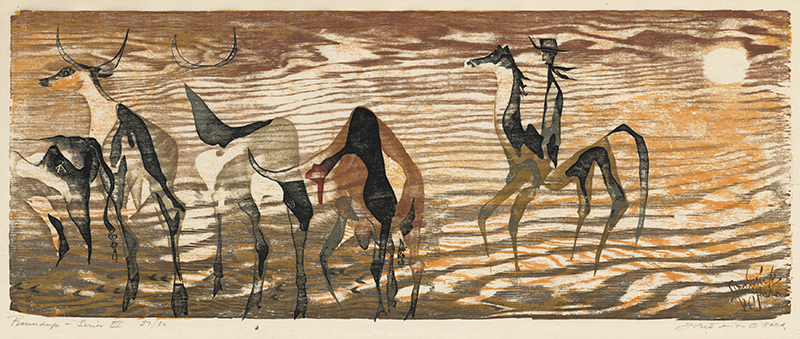Roundup – Series III is a color woodcut from 1954 by American artist Frederick O’Hara (1904-1980). It is pencil signed and titled and editioned 27/30. It was printed by the artist on a thin, ivory wove paper and the image measures 11-13/16 x 28-7/8 inches.
O'Hara’s printmaking was always experimental pushing the edges of imagery and technique. In Roundup, he enhanced the woodgrain of the background block and printed the resulting grainy texture in a couple of different color passes. He then created a herd of longhorn cattle and a cowboy and horse printed in blacks and browns from smaller blocks. The overall composition could well be a response to the 1948 Stan Jones’ western song (Ghost) Riders in the Sky. The first two verses of the song are: An old cowboy went riding out / One dark and windy day / Upon a ridge he rested / As he went along his way / When all at once a mighty herd / Of red eyed cows he saw / Plowin' through the ragged skies / And up the cloudy draw
Frederick O’Hara, painter, printmaker, and teacher, was born on 6 August 1904 in Ottawa, Canada and was named James Frederick O’Hara. His family moved to the United States in 1918 settling in Newport News, Virginia. As a young man, having failed the Harvard College entrance examinations, O’Hara journeyed to Boston hoping to enhance his education and his chances on future examinations. He was hired as a copy boy at the Boston Globe with the caveat that he study commercial art techniques.
O’Hara enrolled at the Massachusetts Normal Art School where he studied between 1922 and 1926 and received his diploma. He then studied at the School of the Museum of Fine Arts Boston between 1926 and 1929. O’Hara received a Paige Traveling Scholarship in 1929 and used it to travel for six years to the various European art centers and to study at Instituto de Bellas Artes in Toledo, Spain.
He returned to the United States in 1935 and had several exhibitions of his work in venues in Boston, Connecticut, and New York. O’Hara also taught for a year at the William and Mary extension in Norfolk, Virginia. He was hired to direct the Santa Barbara School of the Arts in California (1937-1939) and on his route there he visited New Mexico for the first time.
After marrying Mary Louise Robinson in 1939, the couple moved to Suffern, New York and then to Tucson, Arizona in 1940. The following year they moved to a small ranch on the Guadalupe Trail, north of Albuquerque, New Mexico, and O’Hara began teaching painting intermittingly at the University of New Mexico Albuquerque. In 1949, printmaker Adja Yunkers moved to Albuquerque and the two artists became fast friends. Yunkers taught O’Hara his woodcutting and monotype techniques. The following year O’Hara learned lithography from New Mexico printmaker Elmer Schooley.
O’Hara began a series of experimental prints, transferring his monotypes onto lithographic plates, which he describes in detail in an essay “An Adventure in Printmaking” in 1960. His technique included stencil, Formica and paper cut outs and unusual inking to create his abstract images which focused heavily on Navajo culture and spirituality. He authored “Toward Technical Excellence in Printmaking” for Artist’s Proof magazine in 1961. O’Hara create a series of color lithographs at the newly founded Tamarind Workshop in Los Angeles, California between 1961 and 1962. In 1962 O’Hara moved to La Jolla, California and during this period his work became more figurative.
James Frederick O’Hara’s works are represented in the collections of the Blanton Museum of Art, University of Texas at Austin; the Art Institute of Chicago, Illinois; the Fogg Museum, Harvard Art Museums, Cambridge, Massachusetts; the Hammer Museum, University of California, Los Angeles; the Roswell Museum and Art Center, New Mexico; the AD&A Museum, University of California Santa Barbara; the New Mexico Museum of Art, Santa Fe; the Syracuse University Art Museum, New York; and the National Gallery of Art, Washington, D.C.
Frederick O’Hara died in La Jolla, California on March 28, 1980.



